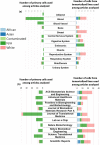Ancestral Background Is Underreported in Regenerative Engineering
- PMID: 34778512
- PMCID: PMC8577639
- DOI: 10.1007/s40883-021-00237-8
Ancestral Background Is Underreported in Regenerative Engineering
Abstract
Purpose: The ancestral background of human cells may play a role in cells' behavior and response to therapeutic interventions in vitro. We investigate the prevalence of ancestry reporting in current biological research and suggest that increased reporting would be beneficial to the field.
Methods: Articles published over a six-month period in ten different journals were reviewed for their use of human primary cells and immortalized cell lines, and were analyzed based on whether or not the ancestral or ethnic information of cell donors was ascertainable.
Results: The vast majority of literature published in the journals and timeframe we investigated did not report on the ancestral or ethnic origins of the human cells used.
Conclusion: There is currently a substantial lack of reporting on the ancestral background of human cells used for research. We suggest that increased ancestral reporting should be implemented in order to improve the development of precision medicine.
Lay summary: Many diseases affect patients of different ancestral backgrounds in a variety of ways. In this perspective article, we raise the concern that, since many scientists do not consider ancestry when designing their studies, their results may not apply to all patients. We use data to show that very few scientists report on the ancestry of the donors who contribute cells and tissues to their research. We suggest that broader reporting on donor ancestry would improve biomedical research and would help doctors to personalize treatments for their patients.Future work includes further increasing awareness of the importance of including ancestry as a variable in experimental design, as well as promoting increased reporting on ancestry in the research community.
Supplementary information: The online version contains supplementary material available at 10.1007/s40883-021-00237-8.
© The Author(s), under exclusive licence to The Regenerative Engineering Society 2021.
Conflict of interest statement
Conflict of InterestThe authors declare no competing interests.
Figures


References
-
- Serjeant GR. The natural history of sickle cell disease. Cold Spring Harb Perspect Med. 2013;3(10):a011783. Available from: https://pubmed.ncbi.nlm.nih.gov/23813607/. Accessed 24 March 2021. - PMC - PubMed
-
- Yedjou C, Tchounwou P, Payton M, Miele L, Fonseca D, Lowe L, et al. Assessing the racial and ethnic disparities in breast cancer mortality in the United States. Int J Environ Res Public Health [Internet]. 2017;14:486. Available from: http://www.mdpi.com/1660-4601/14/5/486. Accessed 24 March 2021. - PMC - PubMed
-
- Duconge J, Ruaño G. Admixture and ethno-specific alleles: missing links for global pharmacogenomics. 10.2217/pgs-2016-0115 [Internet]. Future Medicine Ltd London, UK ; 2016 [cited 2021 Sep 16];17:1479–82. 10.2217/pgs-2016-0115 - PubMed
-
- Hackmann M, Wizemann T, Beachy SH. Exploring sources of variability related to the clinical translation of regenerative engineering products: proceedings of a workshop [Internet]. Washington, DC: The National Academies Press; 2019 [cited 2021 Sep 15]. Available from: https://www.nap.edu/download/25371. Accessed 15 Sept 2021. - PubMed
-
- Dutil J, Chen Z, Monteiro AN, Teer JK, Eschrich SA. An interactive resource to probe genetic diversity and estimated ancestry in cancer cell lines. 2019. [cited 2021 Mar 24]; Available from: http://cancerres.aacrjournals.org/. Accessed 24 March 2021. - PMC - PubMed
Publication types
Grants and funding
LinkOut - more resources
Full Text Sources
Research Materials
